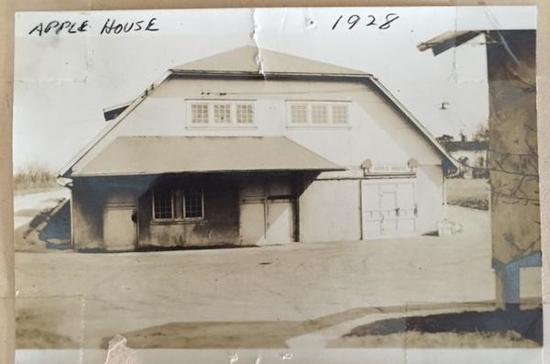Downloads
Full view (jpeg: 53.87 KB)
Learn more about copyright and access restrictions for use of materials from Worthington Memory.
Photograph of the Apple House Exterior at the Brown Fruit Farm is a picture, with genre photograph and historic buildings. Its dimensions are 5.5 in. x 8.4 in..
It was created in 1928.
Shown here is the Apple House at the Brown Fruit Farm.
The farm operated north of Worthington for nearly fifty years, from around 1912 to 1958. It grew and sold apples and apple products such as juice, candy and apple butter, as well as cherries, plums and honey. As of 1925, the farm encompassed 100 acres planted with 4000 fruit trees and was the largest fruit farm in central Ohio. It was renowned not only for the quality of its produce, but also for its innovative roadside marketing, including signs telling motorists how many miles they were from the farm.
The farm’s original apple orchards were planted around 1901, by Frank Bower, on property once owned by the Pool family. Sally and Joseph Pool came to Sharon Township in 1812, and their family gravestones have been incorporated into a restored cemetery at Highbanks Metro Park. Bower sold the orchards to William C. Brown in 1909, who few years later turned the property over to his son, Frame. Over the next couple of decades, Frame grew the farm with cutting-edge farming and marketing techniques. Frame and his wife, Marie, and daughter, Molly, lived in the old farmhouse on the property that had been built by the Pool family. Frame and Marie Brown both passed away in 1936, when Molly Brown took over ownership of the farm, which operated until 1958.
The Apple House was where apples were sorted and packed for sale. Apples in storage were kept at the ideal temperature of 40 degrees, then sent by the crate on ramps with rollers to the Apple House, where they were sorted by size by the apple-grader machine. Workers on either side of the line removed blemished apples. Crates of sorted apples were then placed in the retail showroom at the front of the Apple House.
As recalled by Bernard (Brownie) Cellar in his book “The Brown Fruit Farm: 100 Acres in Orchards,” the roller ramps “supplied the children of the five tenant families hours of pleasure for, when not carrying apple crates, the rollers became a raceway as we placed flat boards at the upper end of the storage barn and rode the rollers all the way from the darkness of that barn across the driveway between buildings to the Apple House.”
It covers the topics agriculture and buildings.
It features the organization Brown Fruit Farm.
It covers the city Columbus.
The original is in a private collection.
This file was reformatted digital in the format video/jpeg.
The Worthington Memory identification code is wcd0237.
This metadata record was human prepared by Worthington Libraries on March 21, 2018.

